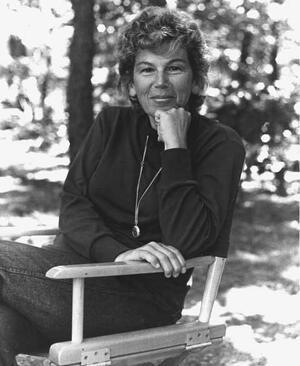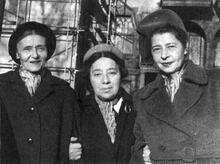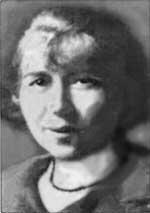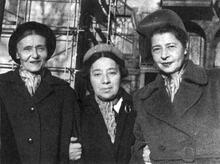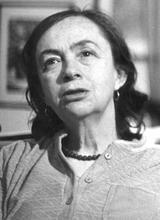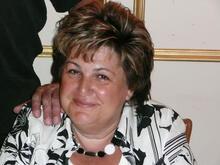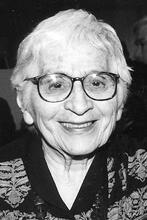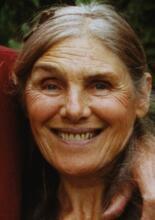Miriam Dworkin Waddington
Miriam Dworkin Waddington was born to an intensely Yiddishist family in the North End of Winnipeg. Although the move to Ottawa with her family took her away from that milieu, she did encounter the vibrant Yiddish cultural life in Montreal through her acquaintance with Ida Maze. She is widely recognized as a powerful and modernist feminist voice in Canadian poetry. Her poetry and literary criticism were considerably influenced by her Jewish identity and values. Waddington’s work has left an indelible impression on Canadian and Jewish letters in Canada. Her considerable achievement in poetry is apparent in a two-volume critical edition of her poetry, edited by Ruth Panofsky.
Youth in Winnipeg and Ottawa
Miriam Waddington, née Dworkin, was born to Russian immigrant parents in the intensely Jewish atmosphere of Winnipeg’s North End on December 23, 1917. She was the second of four children and the only girl. She had an older brother, Alec, and two younger twin brothers, Dave and Sol. Her father, Isaac (Itcheh) Dworkin, arrived in Canada towards the end of the first decade of the twentieth century at the age of twenty; her mother Masha moved to Winnipeg after living in Chicago and then headed north and served as a nurse’s aide in Moose Jaw, Saskatchewan.
Both Itcheh and Masha were secularist and socialist Jews, and their social circle in Winnipeg and at the nearby summer vacation spots included local and visiting Yiddish intellectuals and other avowedly anti-bourgeois women and men. A portrait of I. L. Peretz in the dining room of the Dworkin home kept a watchful eye on the comings and goings. The colorful characters of Miriam Dworkin Waddington’s youth populate the stories in Summer at Lonely Beach, as well as some of her other writings. Her early years were also marked by excursions into the Manitoba countryside and beyond. Her parents sent her to a socialist camp in nearby Gimli and her father loved to travel. The whole family at one point took a motoring holiday to Vancouver, British Columbia, camping along the way. The cityscape of Winnipeg and the landscapes of Canada reappear in Waddington’s poetry, usually with great vividness and affection.
Waddington’s first language was Yiddish and her parents looked to reinforce both the language and secular Jewish culture by sending her to the Y. L. Peretz Folk School (established in 1914). Despite strenuous opposition from the religious elements of the community, this highly successful Yiddish day school aimed to instill a progressive Jewish identity in its students. The school’s staff included some renowned and accomplished pedagogues; during Waddington’s time there, the principal was Ya’akov Zipper of the illustrious Shtern family. She apparently drew deeply from the social agenda of the school and at the age of twelve wrote a short essay in Yiddish on the rather weighty topic of Jewish Colonization in the Soviet Union, which appeared in the fifteenth-anniversary volume of the school in 1929.
Although the young Miriam suffered from anti-Jewish taunts on the street, she described in various autobiographic pieces and interviews how her heymish cocoon of home and school was truly peeled away when her parents sent her to the public school system. At the Machray school, she began to confront the Canadian working assumptions of Anglo-Celtic superiority, which included exposure to the canonized English poets. She became self-conscious and ambivalent about her Jewishness and her Yiddish-speaking parents.
But even greater changes were in store. In Winnipeg, her father and a partner had a moderately successful sausage-making business; after litigation, the partner forced Itcheh out of the business, and he was ultimately compelled to uproot his family in 1930 and seek financial stability in Ottawa. While Winnipeg was a truly vibrant outpost of Jewish life, Ottawa had a much smaller—and more anemic—Jewish community. There Waddington attended high school. Her sense of being marginal persisted, but she made friends with another “outsider,” a French Protestant girl. Nevertheless, while in Ottawa, a significant door did open up for her. As had been the case in Winnipeg, Yiddishists found their way to the Dworkin household in the city. One of them, a traveling salesman for men’s haberdashery, was the husband of Ida Maze, who was already a renowned Yiddish poet and equally famous for her attention to Yiddish writers who came to her salon. Maze frequently took Waddington back to his household in Montreal, and at the age of fourteen the young poet met Ida Maze, who listened attentively to the young Miriam’s poetry and guided her towards reading other poets.
Adult Years
In Ottawa, Waddington began attending meetings of an anti-Fascist group, where she met her future husband, a non-Jew named Patrick Waddington. Now that she was dating a non-Jew, her secularist parents, and especially her father, suddenly became less universalistic in outlook, and according to Waddington her father even threatened suicide. They sent Miriam away to earn a degree at the University of Toronto, apparently in the hope that distance would end the relationship. It did not. After a year as a student in the sciences, she transferred to the arts and earned her B.A. degree in English in 1939.
Despite the persistent sense of being an outsider, Waddington benefited from her time at the university by studying with noted teachers such as A. S. P. Woodhouse and the poet Earle Birney. She became active in university life and worked on the campus newspaper. But contrary to her father’s hope, the romance between Miriam and Patrick did not wilt, and they were engaged to be married in 1939. Seeking to improve on a bad situation, her father looked for a rabbi who would convert Waddington and marry the couple. Rabbi Harry Joshua Stern of Montreal agreed, and the two were married.
The couple lived together in Toronto for the next few years. Miriam decided to return to her studies to earn a diploma in Social Work from the University of Toronto (1942). After two years as a case worker at Toronto’s Jewish Family Service, she decided to pursue an M.S.W. at the University of Pennsylvania, in Philadelphia, where she met the renowned Jessie Taft and Virginia Robinson and received her M.S.W in 1945.
Already during her years in Toronto and then in Philadelphia, Waddington was writing poetry whenever her work allowed it. She published her poetry in the small but cutting-edge First Statement, where modernist Canadian poets sought to break away from the excessively colonial moorings of earlier Canadian poetry. During this time she met Dorothy Livesay, who came to her apartment in Toronto as a way of getting to know other young modernist poets.
Over the next fifteen years, Waddington balanced her social work career with starting a family and writing. Between 1945 and 1960 she held a number of social work positions in Montreal. She also participated in the very lively literary scene for poets, much of it revolving around First Statement. Her first son, Marcus, was born in 1946, and Jonathan in 1951. The marriage with Patrick Waddington did not fare well and in 1960 the two separated. She moved to Toronto, where she worked for two years as a casework supervisor for North York Family and Child Service.
An important professional development took place in 1962, when Waddington was appointed a part-time lecturer in the English department at York University in Toronto; two years later she began to teach full-time. She remained in the position until her retirement in 1983. During the Montreal years, and especially during her time at York, Waddington wrote most of her poetry, as well as her criticism. In 1992 she moved to Vancouver to be closer to her son Jonathan and his family.
Miriam Dworkin Waddington died on March 3, 2004.
Yiddish Progressive Outlook in Her Life and Literary Creativity
Any complete evaluation of Waddington’s poetry, prose, and criticism has to come to terms both with the numerous influences on her and with the multiple contexts of her life. Jesse Taft and others in the progressive tradition within social work, the theoretical writings of Otto Rank on creativity, the editor and poet John Sutherland and the modernist group at First Statement, as well as a lecture given by Douglas Grant on public poetry must all be factored in. For our purposes here, though, we will emphasize what many have recognized but few have explored—the impact of her Jewish background. Her ongoing social concerns can be easily related to the passion for social justice within the Yiddish progressive circles of her parents, as well as to her own training in social work. Waddington is credited with being a powerful voice challenging the patriarchal assumptions that persisted among her fellow modernist poets, and it would not be amiss to speculate that the forceful and articulate women of her Yiddishist milieu steeled her for this challenge.
If these are transmuted indications of some Jewish background, there are also the very explicit ways in which Waddington engaged Jewish themes and topics. She translated Yiddish writers, including David Bergelson, Sholem Aleichem, Mani Leib, Itsik Manger, Y. Y. Segal, and Rokhl Korn. In examining her translations of Korn, Seymour Levitan has pointed out that Waddington’s style of translating was to fuse her own poetic voice with that of the author, in an attempt to remain true to the poetic spirit of the original but resulting in two voices singing the one poem.
In her criticism, too, Waddington tried to broaden the horizons of the Canadian canon. In the early 1960s she presented a program on Yiddish poetry on CBC radio. In one of her essays, she compared Moshe Nadir to the beloved Canadian humorist Stephen Leacock. In later years, Waddington also edited a collection of Canadian Jewish short stories, including both Yiddish writers and newer Jewish writers in English and French.
Waddington’s most sustained work of criticism is on the seminal Canadian Jewish author A. M. Klein. While he was still virtually unappreciated in Canadian circles, she included his work in her courses at York University and ultimately published a small volume of criticism and edited a selection of his poems. Waddington admitted that she found her way back to A. M. Klein after being repulsed by her first reading of Second Scroll, which explored the themes of Destruction/Holocaust and Redemption/Israel. Apparently, after reading Emanuel Ringelblum’s diary from the Warsaw ghetto, she realized that Klein was at the very least trying to face the historical enormity of the destruction of Europe’s Jews. As to her reading of Klein’s poetry, the Klein scholar Zailig Pollock has correctly pointed out that Waddington exaggerated the “radical” aspect of some of Klein’s poetry and thus found her own progressive image in Klein. Nevertheless, her pioneering attempt to examine a poet outside the established canon of Canadian poets was a bold move. It could also be an indication of her own poetic sensibilities. She certainly preferred Klein to the testosterone-driven poetry of her Jewish contemporary, Irving Layton.
But poetry is at the core of Waddington’s creativity and it is for her poetry that she justly achieved renown. Her Jewish sensibilities inform much of her poetry, even if the themes are not explicitly Jewish. Nevertheless, the latter are also present. In her earliest volume, she conflates antisemitism and misogyny in the poem “The Bond.” Autobiographical snippets also appear, such as the taunts from her youth (“your father is/a Bolshevik isn’t/he little girl”), or her parents’ objection to her Christian-born husband. Her visits to Poland and Israel also left their mark and her short poem “Elijah” deserves wider appreciation for its haunting allusions to the dead of Poland. In another poem, she searches out Amos in Jerusalem, a prophet much to her liking because of his commitment to social justice.
We may speak of Miriam Dworkin Waddington as the holder of dual citizenship. She was a Canadian, who in her poetry, prose and life tried to fathom and articulate what that meant to her. but she was also a citizen of that transnational entity known as “Yiddishland.” Her commitment to social justice and her attachment to secular Yiddish culture can be seen as flowing from the latter. Her work has left an indelible impression on Canadian and Jewish letters in Canada.
Selected Works
Unpublished Papers
Miriam Waddington donated her papers to the National Archives of Canada (Ottawa); they have been assigned the call number MG 31 D 54. There is an online finding aid.
Poetry
The definitive collection of poetry is the critical edition by Ruth Panofsky, with an insightful introduction. The Collected Poems of Miriam Waddington. 2 vols. Edited by Ruth Panofsky. Ottawa: University of Ottawa Press, 2014.
Prose and Criticism
A. M. Klein. Toronto: Copp Clark, 1970.
John Sutherland: Essays, Controversies and Poems. New Canadian Library, No. 81. Toronto: 1972 (editor and introduction).
Canadian Jewish Short Stories. Toronto: Oxford University Press, 1990 (editor).
Summer at Lonely Beach and Other Stories. Oakville: Mosaic Press/Valley Editions, 1982.
Apartment Seven: Essays Selected and New. Toronto: Oxford University Press, 1989.
Gutkin, Harry, with Mildred Gutkin. The Worst of Times, the Best of Times: Growing up in Winnipeg’s North End. Markham: Fitzhenry & Whiteside, 1987.
Irvine, Dean Jay. “Little histories: Modernist and leftist women poets and magazine editors in Canada, 1926–1956 (Dorothy Livesay, Anne Marriott, P. K. Page, Miriam Waddington).” Ph.D. dissertation, McGill University, 2001.
Jacobs, Maria. “The Personal Poetry of Miriam Waddington.” CVII: Contemporary Verse II 5/1 (Autumn, 1980): 26–33.
McLauchlan, Laura Jane. “Transformation poetics: Refiguring the female subject in the early poetry and life writing of Dorothy Livesay and Miriam Waddington.” Ph.D. dissertation, York University, 1997.
Ricou, L. R. “Into My Green World: The Poetry of Miriam Waddington.” Essays on Canadian Writing 12 (Fall, 1978): 144–161.
Sharpe, Emily Robins. “ ‘The Heart above the Ruins’: Miriam Waddington’s Poetry, the Spanish Civil War, and Jewish Canadian Literature.” Canadian Jewish Studies/Etudes juives canadiennes 26 (2018): 57-74.
Stevens, Peter. Miriam Waddington and Her Works. NP: 1984.

